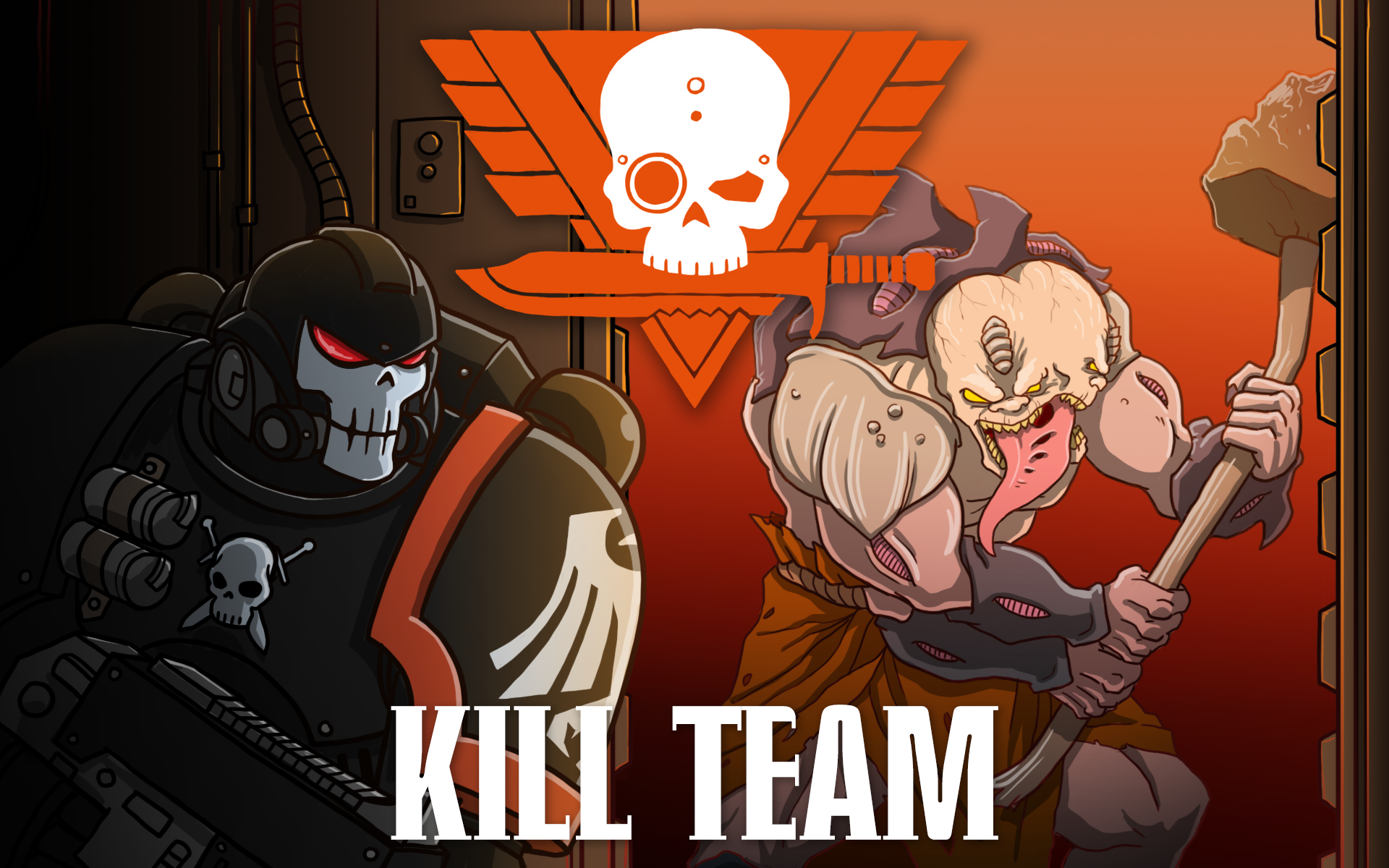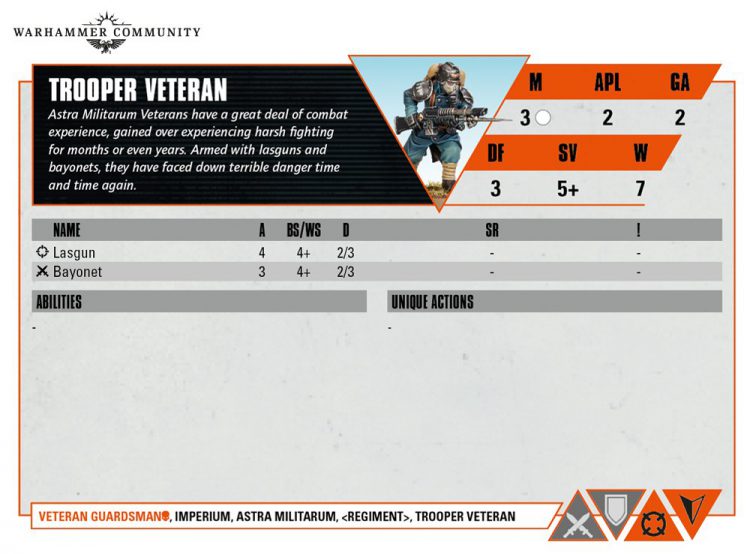The original Kill Team – well, the “original” Kill Team meaning the version of the game that was released during Warhammer 40k’s 8th edition in 2018 – remains one of the more baffling standalone games in the GW library. It simultaneously aspired to be an entry product to 40k, a tight competitive game for tournaments, and a narrative game for campaigns, and accomplished precisely zero of those things. A dismal ruleset with unit stats lifted almost wholesale from full-size 40k and an overall feel of lots of rolling achieving nothing much didn’t help, nor did a deeply confused set of expansion releases which stepped on each other’s toes and created even more conflict in determining what the game was actually for. Then 9th edition dropped and brought with it the Combat Patrol rules that gave us a perfectly workable way to play small, fast games of 40k; set against that was the final Kill Team release for the first edition, the Pariah Nexus box which we could only describe as “cynical,” leaving the game to die an ignoble death.
The good news is that Kill Team 2.0 – set to release in two weeks – is a completely new game, rebuilt from the ground up with all new rules and design sensibilities. Everything about the game has been overhauled, right down to the fundamentals of the datasheets which now bear only a faint resemblance to their 40k counterparts. So how does the new game stack up? Are the new rules a triumph or another minor tragedy? Let’s dive in and find out.
Before we do that however, we’d like to extend a “thank you” to Games Workshop for providing us with preview copies of the new Kill Team boxed set for this review.
A Completely New Kill Team
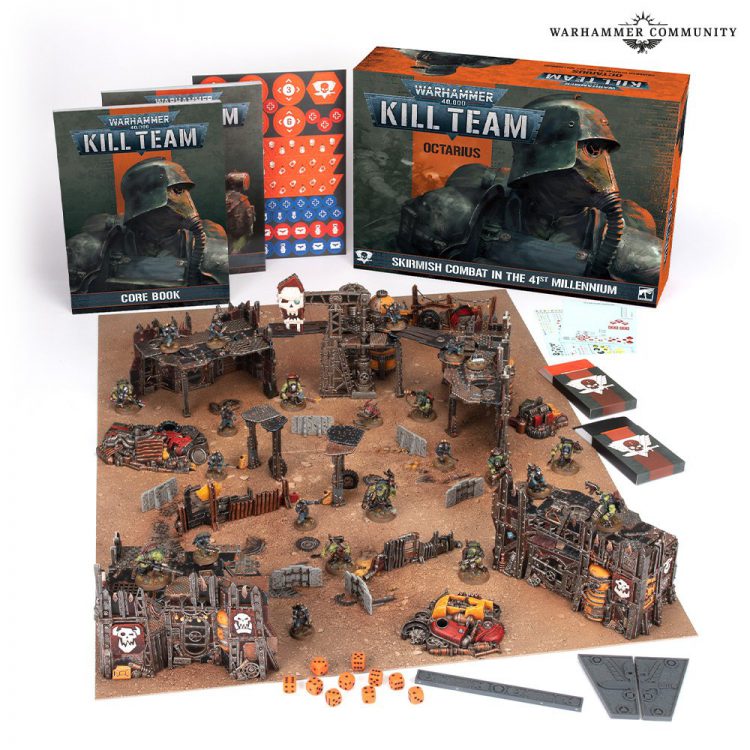
So let’s start with the basics: As you might have seen already, everything in this new game has been completely redone, and in almost every instance, that’s a good thing. The new Kill Team borrows much of the sensibility of Warcry, giving us models with a dozen or more wounds, and much more fixed teams, giving players some flexibility but reducing the wide-open nature of teams. The Council of Exarchs or spamming 12 of the same model with a plasma gun is dead and gone.
The Basics
Games in Kill Team 2.0 take place over four rounds – called Turning Points for some reason – and are split into three phases:
- The Initiative phase, where players roll off to determine who has the Initiative
- The Strategy phase, where players spend CP to use Strategic ploys and reveal hidden objectives called Tac Ops
- The Firefight phase, where the majority of the action happens. This is where players alternate activating models to move, shoot, and fight
So Kill Team 2.0 uses alternating activations, but the way it handles these is entirely different from the 2018 game. Rather than having models activate by phase, models in Kill Team now have a number of Activation Points (APL) they can spend to act however they please in a given turn, allowing for greater flexibility when it comes to moving, shooting, and fighting; in addition, all of these actions are dramatically different in 2.0, driven by completely new datasheets and unit characteristics. There’s a ton of new stuff going on here, so what we’re going to do is pick out some of the highlights to talk about in detail before summarising our overall thoughts at the end.
New Datacards
One of the most striking differences with the new Kill Team – along with the way damage is handled, which we’ll discuss in a moment – is the complete redesign of unit datascards. Gone are the Warhammer 40,000 statlines that governed models in the old game. Models in Kill Team have 6 characteristics, only a few of which are shared with their 40k counterparts:
- Movement, how far the unit can move when making a Normal Move
- APL, or Action Points Limit, which determines how many actions they can make in an activation
- GA, or Group Activations, which tells you how many models of this type activate at a time – most models activate one at a time, but for swarms and hordes you might activate multiples (Poxwalkers activate 2 models at a time, for example).
- DF, Defense, is how many dice you roll when defending with the model.
- SV, or Save, is what you need to roll to save when defending.
- W, Wounds, is how much damage the model can take before it falls over dead.
- In addition to these, weapons have a number of Attacks, BS (What they need to hit), and Damage values, plus they can have extra special rules that apply to them.
On the wounds side, models in Kill Team have lots of wounds. An average Guardsman has 7 wounds to play with, which is enough to take two non-critical bolter shots and stay upright, while Custodes stride onto the board with 18 apiece and a 2+ save to shrug off incoming damage. Likewise, activations scale as well – that same Guardsman and other mortals tend to have 2 APL, while Marines have 3 and Custodes have 4, enabling the latter to do more with fewer models, and keeping things relatively balanced.
Thankfully, the old damage system is gone
The biggest stinker of the old game was the damage system. Everything in the game had an effective 4+ Feel No Pain, turning every exchange of fire into a slow grind, and the system actively punished you for utilising the natural counter to this, weapons with high numbers of shots, since there was every chance a majority of them would be completely wasted.
In the new Kill Team, the damage system has been completely overhauled. When you shoot at an enemy you now roll your attacks, hitting where you beat your BS score for the weapon, and note any 6s – these are critical hits. Your opponent rolls their defense dice, and does the same. A critical defense roll can cancel out a normal or critical hit, a normal defense can cancel out a normal hit, and two normal defense rolls can be used to cancel one critical hit. Often you’ll find that models have more shots than the target has defense dice, so a good roll can guarantee you’ll push some damage through.
The result of the new wound totals and damage system is that whether you’re up against hordes or 4 golden gods, combat no longer feels like a string of failures punctuated by the odd lucky success, and instead you can wear models down until you finally take them down. It’s a game full of small successes which add up to kills that feel satisfying, rather than one of frustratedly praying that the wound actually works this time, and there are legitimate advantages to both large and small teams.

Hand-to-Hand Combat is Just Brutal
Melee combat is also significantly changed in the new game. The attacker and defender both roll their attacks for the weapon they’re attacking with, keeping any hits and critical hits (6s) they score. Then, starting with the attacker, each player picks one of their hits and may choose to either apply it to do damage to the opponent or parry (i.e. negate) one of their opponent’s attacks (crits are required to negate crits). This leads to an interesting situation where the attacker still has the advantage – they get to do damage first, and if they kill their target in one hit, they escape without a scratch and can act again if they have the APL – but most of the time you’re likely to take damage back. This is especially true if you have the ability to kill your target and no amount of defending will save them – they’ll just do as much damage to you as possible before you kill them.
This results in melee combat that is brutal and difficult to escape without taking damage, even against weaker targets. In some ways that’s very flavorful, but it takes a lot of getting used to, particularly for 40k players used to powerful melee units eviscerating targets with no fear of reprisal. Melee in Kill Team 2.0 seems much more of a tool you use to finish something off as part of a coordinated attack than something you do as your first way of engaging with a target, encouraging a combined arms playstyle of softening something up before diving in to finish it off with a melee heavy hitter.
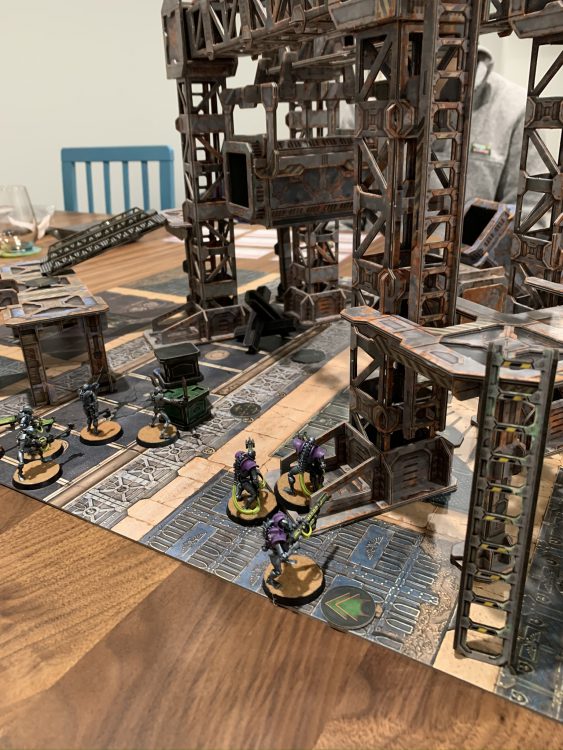
Engage and Conceal Orders
A critical new addition to the system are the Engage and Conceal orders, basic statuses that you set for your operatives each time they’re activated (and pre-game, so they start in one or the other). Throughout the rules you will see mention of Engage and Conceal orders for operatives; they define how you interact with line of sight and cover, as well as what you can do each turn – some actions are limited based upon what order an operative is under. These rules let you keep operatives hidden as they attempt to move across the battlefield, and a model that’s concealed can’t be seen if it has the benefit of cover – it’s assumed to be hiding.
You would think such a fundamental underpinning of the game would be front and centre in the rules, but unless you have read very carefully, it’s possible that you could completely miss where this is introduced (p.59, third paragraph). This vital part of the game is more or less just mentioned in passing as if you already knew about it; really we’re calling it out here less to talk about what it does and more to make sure you don’t miss it completely. It would have been very helpful to have them broken out into a highlighted rule section, like most of the other core rules concepts. Just for clarity: operatives begin the game marked as Engage or Conceal during the Set Up Operatives mission sequence and you can then change their order in subsequent Turning Points when they are activated during the Firefight phase.
Let’s Talk about the Measurement System, I Guess
Much hay has been made about the new game’s measurement system, which uses symbols – ▲, ●, ■, and ⬟ – for distances corresponding to 1, 2, 3, and 6 inches, respectively. The boxed set comes with measuring tools for each of these distances and on the whole, this system works fine – provided you actually have the tools on hand, that is. If you don’t have these or a custom measuring tool on-hand (feel free to just draw the symbols on your standard 40k tool), then doing the mental conversions each time is a pretty big pain in the ass. With the tools provided on a physical table, though? It’s fine, and things work out smoothly; the game does actually use the idea of movement being in discrete increments to do some interesting things, such as leaping over gaps between buildings or dropping down from a height; more prosaically all movements in KT are made in straight lines, so if you want to move around something it helps to have more or longer increments available to do that.

Building a Kill Team
Building your kill team has been dramatically simplified. Rather than having to worry about how to make the points for another model while keeping that special weapon you really ought to bring, you now choose a couple of Fire Teams from a fixed set based on your faction. Each Fire Team has a fixed number of operatives, and you can upgrade a handful of them to bring special weapons, icons, or wargear, and often you’ll pick one to be your Leader – more on that in a bit.
So your Army Roster is 20 models, organized into fire teams, and when you build your Kill Team, you do so using one or two of these fire teams – how many depends on your faction. A fire team might look like “10 Veteran Guardsmen”, picked from a list of options like “SNIPER VETERAN” or “GUNNER VETERAN,” who have specific wargear options (the former getting a sniper rifle and the latter being able to take a plasma gun, respectively). Or a fire team might look like “5 Primaris Intercessors” or “8 Poxwalkers.”
As mentioned above, your Kill Team will likely include a single Leader model, who still gives you some extra CP. Unlike last edition, though, the bonus here is a fixed 2CP at the start of the game, meaning you’ll start with 3CP if you bring a Leader, then gain another CP every round to spend on Strategic and Tactical Ploys. This is a big advantage over old Kill Team, which tied Leader CP generation to the model being alive. The result was a preference for minimum-cost Leaders who could spend all game hiding in order to ensure they kept generating the CP you needed. This new system does away with all that, giving you a strong incentive to bring a leader without preventing them from being a useful member of your Kill Team.
While we won’t have the full picture until we look at the Compendium, which includes rules for the majority of the game’s factions, this is a pretty clever way to do things. It’s simple enough that it’s impossible for someone new to screw themselves by building a completely bad team, while still giving players enough freedom within the fire team structure to customize their units. It also makes balancing the game significantly easier, since new units can be added as fire team options in the future, and because the designers don’t have to worry about insanely skewed kill teams of 15 drones. This also has the important knock-on effect that teams hew a lot closer to what’s actually in a particular box; no longer will the answer to building a good Kill Team be “spend as much as an actual 40k army to get a grab-bag of models from across the faction, or 12 of the same gun.” It also means you’ll be swapping out chunks of your team at a time instead of individual models, and that’s a pretty cool way to do things and creates a sense that these are a group of specialists instead of being random mooks chopped and changed at will.
Stratagems and Tactics
One of the key failings of 2018 Kill Team was a seemingly near-endless parade of Tactics for each faction to choose from. You had a dozen or so generic Tactics, 3 for each specialism – though you were typically only using the level 1 tactics – plus another 12-20 for your faction, giving each player a stack of 30+ decisions to make every game, the net result of which was that players would discard most and just focus on the 2-3 they needed most often.
Kill Team 2.0 replaces the former game’s tactics with Strategic and Tactical Ploys. These work much the same as Stratagems in 40k or Tactics in old Kill Team, and cost CP to use. There’s one universal Tactical Ploy – Command Re-roll, which lets you re-roll a single attack or defense die – and each faction has around 6 of their own ploys to choose from, split between Strategic and Tactical.
Strategic Ploys are new to this edition; they’re similar to the Tactics of old, but they can only be played at the top of the round in the Strategy phase, and they tend to have effects that impact your entire Kill Team. For example, the Kommandos’ Dakka! Dakka! Dakka! Strategic Ploy lets any Kommando on your team treat a single failed hit as a successful normal hit if you roll any critical hits when making a Shooting attack.
In contrast, Tactical Ploys are more like Tactics as they were in the past, being used at specific times to generate effects but typically only affecting a single model or those nearby. The Veteran Guardsmans’ In Death, Atonement costs 1 CP and lets a single model that has been killed stick around until the end of your next activation, potentially letting them get in one more turn before they leave the table.
The best part about these are the small number of them available – the effects are meaningful and distinct without being too numerous that you’ll forget them, and only having a small number means that future teams like Kommandos can be added without having to worry about long-term support, though it remains to be seen if Games Workshop can curb its worst impulses and stop itself from adding dozens of new ploys to the game with every expansion.
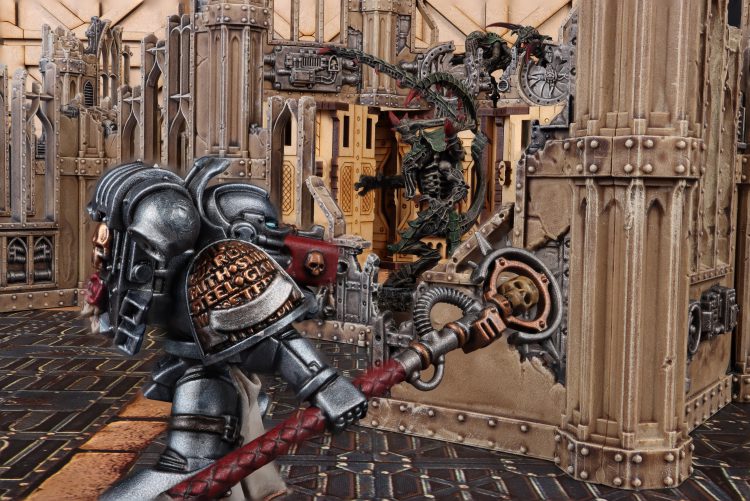
Credit: Pendulin
Three Ways to Play, But For Real This Time
Just like with 40k and Age of Sigmar, Kill Team 2.0 has three ways to play: Open, Matched, and Narrative. This was kind of true with the previous edition of Kill Team, except there were two ways to play Matched play (Matched Play and Arena/Pariah Nexus), and Narrative Play was a complete joke. Well, that’s no longer true – there’s a ton of matched play and narrative play depth now, and both modes look like things we’d actually want to play.
Open Play has been reduced (for the time being) to a single Open War mission, but it’s a straightforward one that makes for a very good intro game scenario. We’ll talk more about it in an upcoming article called “Playing your first game of Kill Team 2.0.”
Narrative Play has been greatly expanded. We’ll talk more about it in tomorrow’s article that’s exclusively about the new Narrative rules, but suffice it to say the new version is like a cross between Crusade and Necromunda. All of the specialisms from the old Kill Team have been moved here, and there’s a base-building aspect where you can customize your team’s HQ between missions for added effects. There’s also Spec Ops, which are like small narrative arcs you choose for your Kill Team to follow along during their games. There’s a ton here and unlike its previous implementation and its pointless husbanding of context-free resource pips it’s a mode we’re actually excited to try out.
Both of those are great but Matched Play gets plenty of focus here as well, with 9 missions in the Core Rulebook to choose from. Matched Play is a bit more involved than Open Play but has some additional balancing factors. One of these is the addition of Tac Ops – the equivalent of 40k’s Secondary Objectives. There are four categories of these, and which categories you can take from depend on your fire teams (a unit of Scouts might give you access to the Infiltration and Recon Tac Ops, while a unit of Kommandos gives you access to Seek and Destroy and Infiltration Tac Ops). Before the game, each player secretly selects three of these (from a set of six), and will reveal them over the course of the game as they attempt to score them. These can range from objectives as simple as “Kill the enemy leader” to “get near the enemy’s drop zone and upload a viral code to their systems” to “capture enemy models to interrogate later.” It’s a bit complicated, but after a couple of games, it’s easy to see how it could be a lot of fun and where you could get some good mind games out of the secret element.
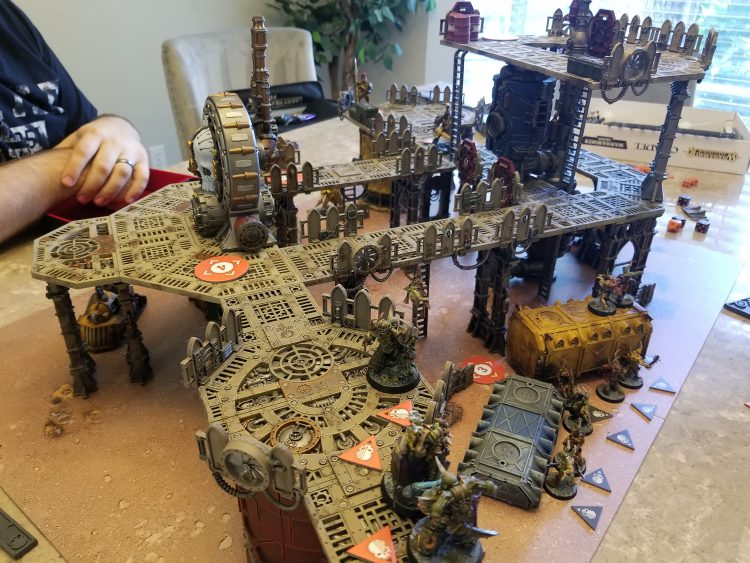
There’s a Lot of Complexity Here
On that note, it’s worth pointing out that the new Kill Team rules are complex. By volume, there’s less than 40k, but there’s still a good 30 or so pages of rules to go through and the rules are going to take you a few games to learn, ideally starting with a barebones version and adding more as you go. While building teams is simpler than ever, there’s a lot of depth to the rules for line of sight and cover, how activations work, and how to manage shooting and combat. We’ve talked before about wanting Kill Team to be its own distinct game, and we have definitely gotten what we’ve asked for here – this is not at all “an intro to 40k” any more and is instead its own complete game which just happens to share some models with its bigger brother.
There is some criticism to be levelled here; while the game as played is completely transformed and feels way more fun than its predecessor, trying to learn it from the rulebook is somewhat challenging, with a lot of back and forth required when the rules e.g. point you 10 pages forward to learn about a concept that’s explained later but is important to understand now to have any real context. We’re generally fans of Games Workshop aiming for greater precision and clarity in their rules writing, and it’s certainly a good thing to try and anticipate edge cases and handle them, but there’s places in the text here where it starts to be so dense it’s unapproachable. Once you’ve gotten models on the table and played things through most of what’s actually happening is straightforward and quick to play, and the rules are then a great resource to go back to and look up a specific interaction, but the first read through is more of a slog than it needs to be and the book could have benefited from another pass to try and make it more accessible.
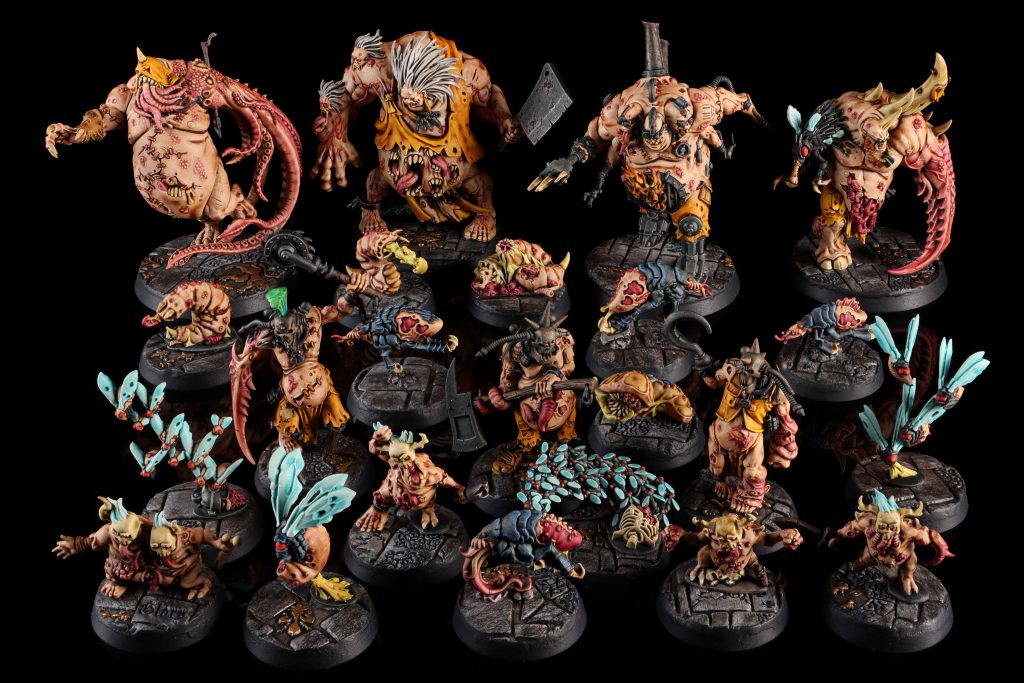
Credit: Pendulin
So Who is This For?
All of this begs the question: Who is this new Kill Team for? Is it for people who want to get into the hobby? People looking for a cheaper way into 40k? People who want a deep skirmish game using 40k models? People who want to run narrative campaigns?
The answer seems to be a mix. As we mentioned above, Kill Team 2.0 is a fully fledged skirmish game that is all but completely separated from 40k-specific rules concepts; this is largely a win, making it a much better game in its own right, but also clearly moves it away from being an intro path to playing regular 40k. The Matched Play rules feel tight enough to make a proper game out of – particularly if GW is willing to provide FAQ support for the game – and so it feels like a great fit for people who want to play a deep, competitive skirmish game using 40k models, and with games taking around 30-60 minutes to complete it’s a big win for something quicker to play on game night that is distinctly different from 40k instead of feeling like a smaller, worse version of what you could have played instead. Additionally, the new narrative play rules are a big step up, with a real campaign system that seems like a great way for 40k players to use their current minis to run smaller, Necromunda-style campaigns, or to dip a toe into a new faction without having to worry about the logistics of building an entire 40k army, even at 500 points.
From the alternative direction, if you’re into the idea of 40k but not the idea of spending hundreds of dollars and dozens of hours on all the models you need for a 2000pt army, this new version of Kill Team is a far better product; as mentioned above, for most factions your likely purchases are “a box or two of guys to make up a couple of fire teams” and not “an entire Eldar army just to get the Exarchs” which makes it vastly more approachable.
On the other hand, if you’re looking for something as a stepping stone into full games of 9th edition, this isn’t the product for you any more. The rules, while significantly improved, are far too different from 40k to teach you much about that game; if all you want to do is get into playing 9th edition 40k you’re likely much better served buying a Combat Patrol and jumping in with 500 point games. Really that’s how it should be, and Kill Team is a fine introduction to the hobby overall; the prospect of someone only having to buy one or two squad boxes to play and then being able to get games done in an hour with much smaller space requirements is a huge upside. Additionally, the game’s alternating activations makes it feel much more active, making the game easier to spectate.
In our opinion, this is exactly what Kill Team always should have been. Having a whole separate product that was sort of like small 40k but with weird little differences, which encouraged building models in ways that made no sense for the bigger game, was never a good idea; creating something distinct which sells people on the idea of 40k and its universe without being stuck with issues inherited from dogging 8th edition’s heels too closely is a much better way to approach it.
If you were a big fan of the previous version you might feel like we’re being a bit harsh on it. Nothing’s stopping you from sticking to the 2018 game, but in our opinion there’s just a lot more to love here, and you’re likely to have a lot more fun with this version than its predecessor.
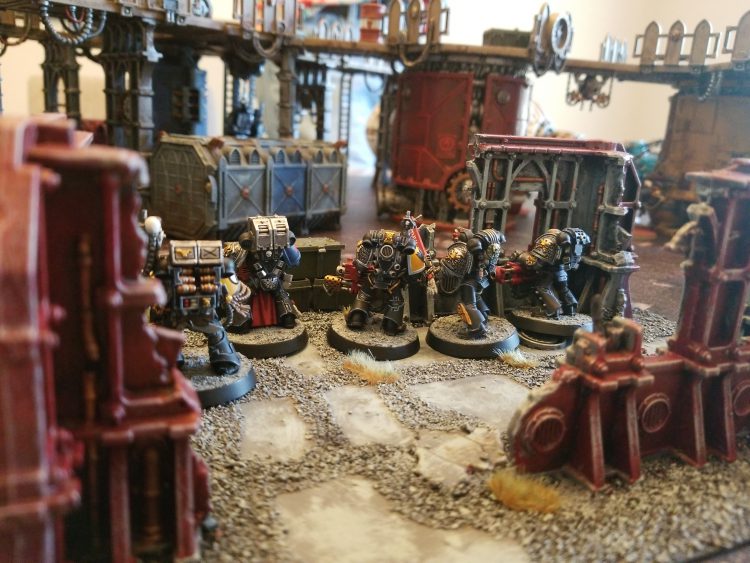
The Breakdown
Alright, before we go into our final verdict, let’s do a quick rundown of what we liked, didn’t like, and were baffled by in the new Kill Team.
The Good
- New datasheets are simple and the wound system feels great – even when you don’t kill a model it feels like you’re accomplishing something, with each team taking chunks out of the other, instead of plinking away with pointless shots hoping for a lucky string of high rolls to do anything meaningful
- Ranged weapons feel right; infinite range on bolters and other rifles makes sense, and while Meltaguns only have 6” range, they will absolutely demolish anything you hit with them, in a way that’s very reminiscent of THQ’s Space Marine
- APL system gives you a lot of flexibility in how to act and helps balance elite teams against hordes
- There’s a good level of depth to the Engage/Conceal order system, making how and when you order operatives meaningful and interesting
- The terrain and models that come in the box are gorgeous, and while we’ll be covering the Octarius book in a separate article, it’s got the feel of a full campaign expansion
The Bad
- While the rules seem pretty solid, the way they’re written is hard to get to grips with and the layout of the book is baffling, with different content all over the place and multiple spots that refer you to other pages for critical info
- Melee-heavy Fire Teams may find themselves overpowered unless they’re played very cautiously, and factions that have famously deadly fighters can see them whittled away by back-and-forth combat damage even in fights they’re going to win overwhelmingly
- There’s a ton of cards and cardboard to punch out in this box, but what I’d have really liked is a pair of reference cards with the game’s generic actions. Not having these seems like a bit of a miss.
The Weird
- The symbol-based measurement really does take some getting used to and it feels a bit like a way to force you to buy custom measurement tools – though these are both in the core box and have now been announced as part of a separate “Kill Team Essentials” release too
- Line of sight and cover and are some of the most obtusely written rules in the book, and not screamingly intuitive – they also make heaviest use of the black ▲ symbol, and so naturally they’re printed on a black background from which it’s nearly totally indistinct
- Calling Turns “Turning Points” is just dumb
Final Verdict
Overall the new Kill Team is almost everything we wanted out of such a release. The new rules feel pretty tight, roster construction is easy, models have lots of wounds, lots of things happen during games, and there’s a campaign mode you’d actually want to play. Add to that some incredible new models and the absolutely wonderful terrain in the box and there are a ton of reasons to recommend both the game in general and the new core set specifically, even if you were turned off by its predecessor. Hell, especially if you were turned off by its predecessor; if you found yourself nodding along with us at the absurdities of KT2018, you’re likely to find this game is much more to your taste.
That wraps up our review of the new Kill Team boxed game but stay tuned as we’ll be offering the same full level of coverage for the new game as we did the old one, including detailed faction reviews, tactics articles, and hobby guides for the game on an ongoing basis. And in the meantime, if you have any questions or feedback, drop us a note in the comments below or email us at contact@goonhammer.com.
